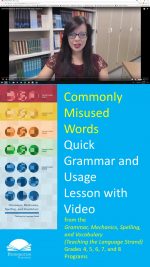Subject Case Pronouns
Subject Case Pronouns
Play the quick video lesson HERE and click the upper left back arrow to return to this lesson.
Common Core Language Standard 1
Just like nouns, English has different types of pronouns for different purposes. To know when to use a “she,” “her,” and “hers” requires a bit of practice.
Today’s grammar and usage lesson is on subject case pronouns. Remember that a pronoun takes the place of a noun. Using subject case pronouns avoids repetitious nouns, especially in dialogue.
Now let’s read the grammar and usage lesson and study the examples.
Writers use pronouns to take the place of nouns. One type of pronoun is called a subject case pronoun because it acts as the subject of a sentence. The subject is the “do-er” of the sentence.
These are the subject case pronouns:
Singular—I, you, he, she, it, who Plural—we, you, they, who
Example: They brought a basket of flowers.
Also use subject case pronouns following “to be” verbs (is, am, are, was, were, be, being, been) to identify or refer to the subject as predicate nominatives. Example: It is I.
Place the first person singular pronoun (I) last in compound subjects. Example: Paul and I left. If unsure whether a pronoun should be in the subject case, rephrase the sentence with the pronoun at the start of the sentence. Example: The winner was me. Rephrase: I was the winner.
Now circle or highlight what is right and revise what is wrong according to grammar and usage lesson.
Practice: Pedro and I just want to know if the burglar really was him or his friend.
Let’s check the Practice Answers.
Grammar and Usage Practice Answers: Pedro and I just want to know if the burglar really was he or his friend.
Now let’s apply what we have learned.
Writing Application: Write your own sentence using singular and plural subject case pronouns.
*****

Pennington Publishing Grammar Programs
Teaching Grammar, Usage, and Mechanics (Grades 4, 5, 6, 7, 8, and High School) are full-year, traditional, grade-level grammar, usage, and mechanics programs with plenty of remedial practice to help students catch up while they keep up with grade-level standards. Twice-per-week, 30-minute, no prep lessons in print or interactive Google slides with a fun secret agent theme. Simple sentence diagrams, mentor texts, video lessons, sentence dictations. Plenty of practice in the writing context. Includes biweekly tests and a final exam.
Grammar, Usage, and Mechanics Interactive Notebook (Grades 4‒8) is a full-year, no prep interactive notebook without all the mess. Twice-per-week, 30-minute, no prep grammar, usage, and mechanics lessons, formatted in Cornell Notes with cartoon response, writing application, 3D graphic organizers (easy cut and paste foldables), and great resource links. No need to create a teacher INB for student make-up work—it’s done for you! Plus, get remedial worksheets, biweekly tests, and a final exam.
Syntax in Reading and Writing is a function-based, sentence level syntax program, designed to build reading comprehension and increase writing sophistication. The 18 parts of speech, phrases, and clauses lessons are each leveled from basic (elementary) to advanced (middle and high school) and feature 5 lesson components (10–15 minutes each): 1. Learn It! 2. Identify It! 3. Explain It! (analysis of challenging sentences) 4. Revise It! (kernel sentences, sentence expansion, syntactic manipulation) 5. Create It! (Short writing application with the syntactic focus in different genre).
Get the Diagnostic Grammar, Usage, and Mechanics Assessments, Matrix, and Final Exam FREE Resource:
![]()







